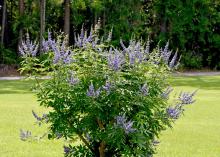Information Possibly Outdated
The information presented on this page was originally released on June 6, 2016. It may not be outdated, but please search our site for more current information. If you plan to quote or reference this information in a publication, please check with the Extension specialist or author before proceeding.
Vitex bloom faithfully each summer in South
The first week of June is one of my favorite times in Mississippi landscapes and gardens. This is the time of the year when the vitex begins to bloom with the regularity of Old Faithful.
The vitex flowering period begins around Memorial Day on the Gulf Coast, and it starts soon afterwards in north Mississippi. The main flowering period lasts up to six weeks, but the show doesn’t stop then. The plants will continue to bloom sporadically for the rest of summer.
There is a vitex planting right outside my office window, and whenever I need to take a little break and stretch, I only need to take a look at the gorgeous clusters of purplish-blue flowers to feel reinvigorated.
In 2002, vitex was named a Mississippi Medallion winner. Vitex is definitely a plant that makes gardeners and nongardeners alike stop and take notice.
The flowers, called spikes, are composed of many clusters of small, individual flowers. In some varieties, these spikes can be up to 18 inches long. Flower color varies from lavender to lilac and pale violet. The color can even be a brilliant, nearly fluorescent blue.
During the initial flush, the show of flowers may resemble a hazy blue or purplish cloud. And on days when there is just the gentlest breeze, you can enjoy the flowers’ delicate, slightly floral scent.
While the straight species Vitex is a great summer plant to look for, also look out for the improved Shoal Creek selection. The vigorous spring/summer flush of these flower spikes is large, and the blooms are a more intense and deeper blue than the regular species. The adventurous and persistent gardener can find pink and white varieties as well.
In 2011, Shoal Creek vitex was named a Louisiana Super Plant.
Vitex leaves are arranged opposite the blooms on distinctly square stems. Plants grow in clusters, with five to nine finger-like leaflets radiating from a single point. When crushed, the stems and foliage smell sweet. The foliage is a dark, gray-green on top and bluish gray underneath. When mature, the leaves have slightly fuzzy undersides.
Vitex thrives in Mississippi’s hot and humid weather extremely well, which makes this an outstanding small tree for our landscapes. It is also a good choice for the droughty periods we have each summer.
While vitex can be grown as a single-trunked tree, I think it is more attractive in the landscape when grown as a multitrunk specimen.
Vitex tolerates a wide range of pruning styles. It can be easily maintained as an 8- to 10-foot small tree. Pruning actually promotes more compact branching, resulting in a thicker, bushier plant. Since vitex flowers on new wood, which is the current season’s growth, pruning actually encourages and enhances flowering.
One of my neighbors cut his small tree-form vitex back to the ground last fall. The plant started growing back this spring and is now a beautiful 3-foot-tall bush. If allowed to grow naturally, it will reach up to 20 feet tall and wide.
Plant your vitex in partial shade to full sun for best flowering performance. While it tolerates a wide variety of soil conditions and textures, make sure the planting bed has a well-drained soil.
Vitex makes a great companion when planted with the Mississippi-Medallion-winning, pink-flowering Sioux and white-flowering Natchez crape myrtles.



